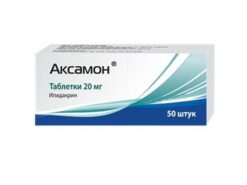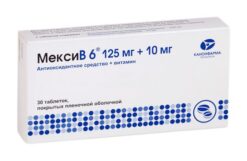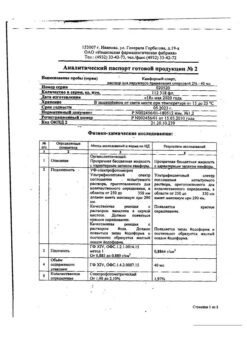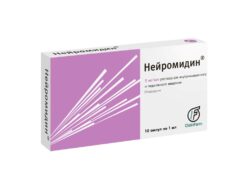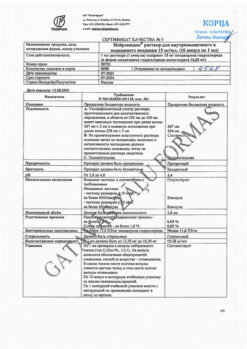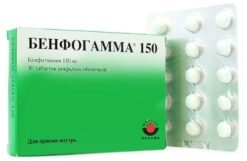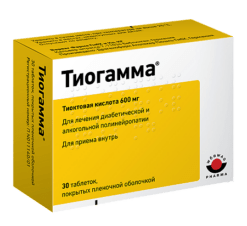Subtotal: €31.29
Quentiax SR prolonged. 200 mg, 60 pcs.
€1.00
Out of stock
(E-mail when Stock is available)
- Schizophrenia, including:
prevent relapse in stable patients.
- Bipolar disorders, including:
moderate and severe manic episodes in the structure of bipolar disorder;
severe episodes of depression in the structure of bipolar disorder;
prevent relapses of bipolar disorder in patients with prior effective quetiapine therapy for manic or depressive episodes in the structure of bipolar disorder.
- Depressive episode:
combination therapy for suboptimal response to antidepressant monotherapy.
Indications
Schizophrenia, including:
prevention of relapses in stable patients.
Bipolar disorders, including:
moderate and severe manic episodes in the structure of bipolar disorder;
severe episodes of depression in the structure of bipolar disorder;
prevention of relapses of bipolar disorders in patients with previous effective treatment with quetiapine for manic or depressive episodes in the structure of bipolar disorder.
Depressive episode:
combination therapy for suboptimal response to antidepressant monotherapy.
Pharmacological effect
antipsychotic (neuroleptic)
Special instructions
Use in patients with cardiovascular and cerebrovascular diseases or other conditions predisposing to arterial hypotension, use in elderly patients, liver failure, history of seizures, risk of stroke and aspiration pneumonia.
Quentiax® SR is not indicated for use in children and adolescents under 18 years of age due to insufficient data on use in this age group.
Elderly patients
As with other antipsychotic drugs, Quentiax® SR should be used with caution in elderly patients, especially at the beginning of therapy. The selection of an effective dose of Quentiax® SR in elderly patients may be slower, and the daily therapeutic dose may be lower than in young patients. The average plasma clearance of quetiapine in elderly patients is 30-50% lower than in young patients. In elderly patients, the initial dose of Quentiax® SR is 50 mg/day. The dose may be increased by 50 mg/day until an effective dose is achieved, depending on the clinical response and tolerability of the drug by the individual patient.
In elderly patients with a depressive episode, the daily dose for the first 3 days of therapy is 50 mg/day, increasing to 100 mg/day on the 4th day and to 150 mg/day on the 8th day. The minimum effective dose of the drug should be used, starting treatment with 50 mg/day. If necessary, the dose of the drug can be increased to 300 mg/day, but not earlier than 22 days of therapy.
Efficacy and safety have not been studied in patients over 65 years of age with depressive episodes as part of bipolar disorder.
Renal dysfunction
For patients with renal failure, no dose adjustment is required.
Liver dysfunction
Quetiapine is extensively metabolized in the liver. As a result, caution should be exercised when using Quentiax® SR in patients with liver failure, especially at the beginning of therapy. It is recommended to begin therapy with Quentiax® SR at a dose of 50 mg/day and increase the dose daily by 50 mg until an effective dose is achieved.
Children and adolescents (ages 10 to 17 years)
Quentiax® SR is not indicated for use in children and adolescents under 18 years of age due to insufficient data on use in this age group. According to the results of clinical studies, some adverse reactions (increased appetite, increased concentration of prolactin in the blood serum, vomiting, rhinitis and fainting) were observed in children and adolescents with a higher frequency than in adult patients, or had other clinical manifestations (EPS and irritability). An increase in blood pressure was also noted, which was not observed in adult patients. Changes in thyroid function have also been observed in children and adolescents.
The effects on growth, puberty, mental development and behavioral reactions with long-term use (more than 26 weeks) of quetiapine have not been studied.
In placebo-controlled studies in children and adolescents with schizophrenia and mania in bipolar disorder, the incidence of EPS was higher with quetiapine compared with placebo.
Suicide/suicidal ideation or clinical worsening
Depression is associated with an increased risk of suicidal ideation, self-harm and suicide (suicide-related events). This risk persists until significant remission occurs. Because it may take several weeks or more for the patient’s condition to improve from the start of treatment, patients should be under close medical supervision until improvement occurs. According to generally accepted clinical experience, the risk of suicide may increase in the early stages of remission.
In short-term, placebo-controlled clinical trials in depressed patients with bipolar disorder, the risk of suicide-related events was 3.0% (7/233) for quetiapine and 0% (0/120) for placebo in patients aged 18–24 years, 1.8% (19/1616) for quetiapine and 1.8% (11/622) for placebo in patients aged ≥ 25 years. A population-based retrospective study of quetiapine in patients with major depressive disorder found an increased risk of self-harm and suicide attempts in patients aged 25 to 64 years without a history of self-harm taking quetiapine with other antidepressants.
Other psychiatric disorders treated with quetiapine are also associated with an increased risk of suicide-related events. In addition, such conditions may be comorbid with a depressive episode. Thus, the precautions used when treating patients with a depressive episode should also be taken when treating patients with other mental disorders.
If quetiapine therapy is abruptly discontinued, the potential risk of suicide-related events should be taken into account.
Patients with a history of suicidal events, as well as patients who clearly express suicidal thoughts before starting therapy, are at increased risk of suicidal intent and suicide attempts and should be carefully monitored during treatment.
In patients with manic bipolar disorder, the risk of suicide-related events was 0% (0/60) for quetiapine and 0% (0/58) for placebo in patients aged 18–24 years, 1.2% (6/496) for quetiapine and 1.2% (6/503) for placebo in patients aged ≥ 25 years, 1.0% (2/193) for quetiapine and 0% (0/90) for placebo in patients under 18 years of age.
In patients with schizophrenia, the risk of suicide-related events was 1.4% (3/212) for quetiapine and 1.6% (1/62) for placebo in patients aged 18–24 years, 0.8% (13/1663) for quetiapine and 1.1% (5/463) for placebo in patients aged ≥ 25 years, 1.4% (2/147) for quetiapine and 1.3% (1/75) for placebo in patients under 18 years of age.
In patients with a depressive episode, the risk of suicide-related events was 2.1% (3/144) for quetiapine and 1.3% (1/75) for placebo in patients aged 18–24 years, 0.6% (11/1798) for quetiapine and 0.7% (7/1054) for placebo in patients aged ≥ 25 years. Patients under the age of 18 years did not participate in studies for this indication.
Overall, the rate of suicide events was 0.8% for both quetiapine (76/9327) and placebo (37/4845) in short-term placebo-controlled studies across all indications and all age groups.
An FDA meta-analysis of placebo-controlled studies of antidepressants, summarizing data from approximately 4,400 children and adolescents and 7,700 adult patients with mental disorders, found an increased risk of suicidal behavior with antidepressants compared with placebo in children, adolescents and adult patients under 25 years of age. This meta-analysis does not include studies using quetiapine (see Pharmacodynamics section).
Extrapyramidal symptoms
There was an increase in the incidence of EPS when taking quetiapine in adult patients with a major depressive episode in the structure of bipolar disorder or major depressive disorder compared to placebo (see section “Side effects”). However, during quetiapine therapy in patients with schizophrenia and mania in the structure of bipolar disorder, there was no increase in the incidence of EPS compared to placebo.
Tardive dyskinesia
While taking antipsychotics, including quetiapine, tardive dyskinesia may occur, which is manifested by violent involuntary movements and may be irreversible. If symptoms of tardive dyskinesia develop, it is recommended to reduce the dose of the drug or gradually discontinue it. Symptoms of tardive dyskinesia may intensify or even occur after stopping the drug (see section “Side effects”).
While taking quetiapine, akathisia may occur, which is characterized by an unpleasant feeling of motor restlessness and the need to move and is manifested by the patient’s inability to sit or stand without moving. If such symptoms occur, the dose of quetiapine should not be increased.
Drowsiness and dizziness
During quetiapine therapy, drowsiness and associated symptoms, such as sedation, may occur (see section “Side effects”). In clinical studies involving patients with depression in the structure of bipolar disorder and with a depressive episode, somnolence usually developed during the first three days of therapy. The severity of this adverse reaction was generally minor or moderate. If severe drowsiness develops, patients with depression as part of bipolar disorder and patients with a depressive episode may require more frequent visits to the doctor within 2 weeks from the onset of drowsiness or until the severity of symptoms decreases. In some cases, discontinuation of quetiapine therapy may be necessary.
During quetiapine therapy, orthostatic hypotension and dizziness may occur (see section “Side effects”), usually during dose titration at the beginning of therapy. Patients, especially older patients, should be careful to avoid accidental injury (falls).
Patients with cardiovascular diseases
Caution should be exercised when using quetiapine in patients with cardiovascular, cerebrovascular disease and other conditions predisposing to arterial hypotension. In such patients, dose selection should be slower. Orthostatic hypotension may occur during quetiapine therapy, especially during dose titration at the beginning of therapy. If orthostatic hypotension occurs, a dose reduction or more gradual titration may be required.
Sleep apnea syndrome
Sleep apnea syndrome has been reported in patients taking quetiapine. Caution should be exercised when prescribing quetiapine to patients receiving drugs that have a depressant effect on the central nervous system, as well as patients with risk factors for sleep apnea (for example, overweight/obesity, male gender) or with a history of sleep apnea.
Seizures
There were no differences in the incidence of seizures in patients taking quetiapine or placebo. However, as with other antipsychotic drugs, caution is recommended when treating patients with a history of seizures (see section “Side effects”).
Neuroleptic malignant syndrome
While taking antipsychotic drugs, including quetiapine, neuroleptic malignant syndrome may develop (see section “Side effects”). Clinical manifestations of the syndrome include hyperthermia, altered mental status, muscle rigidity, lability of the autonomic nervous system, and increased creatine phosphokinase activity. In such cases, it is necessary to stop taking quetiapine and carry out appropriate treatment.
Severe neutropenia and agranulocytosis
In short-term, placebo-controlled clinical trials of quetiapine monotherapy, cases of severe neutropenia (neutrophil count <0.5 x 109/L) without infection were reported infrequently. The development of agranulocytosis (severe neutropenia associated with infections) has been reported in patients receiving quetiapine in clinical trials (rare), as well as during post-registration use (including death). Most of these cases of severe neutropenia occurred several months after initiation of quetiapine therapy. No dose-dependent effect was found. Leukopenia and/or neutropenia resolved after discontinuation of quetiapine therapy. Possible risk factors for the occurrence of neutropenia are a previous low white blood cell count and a history of drug-induced neutropenia. The development of agranulocytosis was also noted in patients without risk factors. The possibility of neutropenia should be considered in patients with infection, especially in the absence of obvious predisposing factors, or in patients with unexplained fever, and these cases should be managed in accordance with clinical guidelines.
In patients with a neutrophil count <1.0 x 109/L, quetiapine should be discontinued. The patient should be observed for possible symptoms of infection and the neutrophil count should be monitored (until the count rises to 1.5 x 109/L).
Anticholinergic (muscarinic-like) effects
Norquetiapine, the active metabolite of quetiapine, has moderate to strong affinity for several muscarinic receptor subtypes. This is associated with ADRs caused by the anticholinergic effect of quetiapine when used in recommended doses or when used simultaneously with other drugs that have anticholinergic effects, as well as in overdose. Caution should be exercised when using quetiapine concomitantly with drugs that have anticholinergic (muscarinic-like) effects. Caution should be exercised when prescribing to patients with urinary retention or a history of urinary retention, clinically significant prostatic hyperplasia, intestinal obstruction or related conditions, increased intraocular pressure or angle-closure glaucoma (see sections “Pharmacodynamics”, “Side effects”, “Overdose” and “Interaction with other drugs”).
Interaction with other drugs
Also see the section “Interaction with other drugs”.
The simultaneous use of quetiapine with powerful inducers of microsomal liver enzymes, such as carbamazepine and phenytoin, helps to reduce the concentration of quetiapine in the blood plasma and may reduce the effectiveness of therapy with Quentiax® SR.
The use of Quentiax® SR in patients receiving microsomal liver enzyme inducers is possible only if the expected benefit from therapy with Quentiax® SR outweighs the risk associated with discontinuation of microsomal liver enzyme inducers. Changing the dose of drugs that induce microsomal liver enzymes should be gradual. If necessary, they can be replaced with drugs that do not induce microsomal liver enzymes (for example, valproic acid drugs).
Body weight
An increase in body weight was observed while taking quetiapine. Clinical monitoring of patients is recommended in accordance with accepted standards of therapy (see section “Side Effects”).
Hyperglycemia
While taking quetiapine, it is possible to develop hyperglycemia and/or develop and exacerbate diabetes mellitus, sometimes accompanied by ketoacidosis or coma. Regular monitoring of body weight and symptoms of hyperglycemia, such as polydipsia, polyuria, polyphagia and weakness, is recommended in patients taking antipsychotics, including quetiapine. Clinical monitoring of patients with diabetes mellitus and patients with risk factors for developing diabetes mellitus is recommended (see section “Side Effects”).
Lipid concentration
While taking quetiapine, it is possible to increase the concentration of triglycerides, total cholesterol and LDL cholesterol, as well as a decrease in the concentration of HDL in the blood plasma (see section “Side Effects”). These changes should be adjusted in accordance with current recommendations.
Metabolic disorders
An increase in body weight, an increase in the concentration of glucose and lipids in the blood plasma in some patients can lead to a deterioration in the metabolic profile, which requires appropriate monitoring.
QT prolongation
There was no relationship between taking quetiapine and a persistent increase in the absolute value of the QT interval. However, prolongation of the QT interval has been observed with the use of quetiapine in therapeutic doses and with an overdose of quetiapine (see section “Overdose”). Caution should be exercised when using quetiapine, as with other antipsychotic drugs, in patients with cardiovascular disease and a history of QT prolongation. Caution should also be exercised when using quetiapine simultaneously with drugs that prolong the QTc interval, other antipsychotics, especially in the elderly, in patients with congenital long QT syndrome, chronic heart failure, myocardial hypertrophy, hypokalemia or hypomagnesemia (see section “Interaction with other drugs”).
Acute reactions associated with drug withdrawal
If quetiapine is abruptly discontinued, the following acute reactions (withdrawal syndrome) may occur: nausea, vomiting, insomnia, headache, dizziness and irritability. Therefore, it is recommended to discontinue Quentiax® SR gradually over at least one or two weeks.
Misuse and Abuse
Cases of misuse and abuse of the drug have been reported. Caution should be exercised when prescribing quetiapine to patients with a history of alcohol or drug abuse.
Elderly patients with dementia
Quentiax® SR is not indicated for the treatment of psychoses associated with dementia. Some atypical antipsychotics in randomized placebo-controlled trials increased the risk of cerebrovascular events in patients with dementia by approximately 3-fold. The mechanism for this increased risk has not been studied. A similar risk of increased incidence of cerebrovascular complications cannot be excluded for other antipsychotic drugs or other patient groups. Quentiax® SR should be used with caution in patients at risk of stroke.
An analysis of the use of atypical antipsychotics for the treatment of psychosis associated with dementia in elderly patients revealed an increased mortality rate in the group of patients receiving drugs of this group compared with the placebo group. Two 10-week placebo-controlled studies of quetiapine in a similar group of patients (n=710, mean age: 83 years, age range: 56-99 years) showed that mortality in the quetiapine group was 5.5%, and 3.2% in the placebo group. The causes of death observed in these patients were consistent with those expected for this population. No causal relationship has been identified between quetiapine treatment and the risk of increased mortality in elderly patients with dementia.
Elderly patients with Parkinson’s disease/parkinsonism
A population-based retrospective study of quetiapine in patients with major depressive disorder found an increased risk of death in patients aged > 65 years. An increased risk was not detected when patients with Parkinson’s disease were excluded from the analysis. Caution should be exercised when prescribing quetiapine to elderly patients with Parkinson’s disease.
Liver disorders
If jaundice develops, quetiapine should be discontinued.
Dysphagia
Dysphagia (see section “Side effects”) and aspiration were observed during therapy with quetiapine. The cause-and-effect relationship between the occurrence of aspiration pneumonia and the use of quetiapine has not been established. However, caution should be exercised when using Quentiax® SR in patients at risk of aspiration pneumonia.
Venous thromboembolism
Cases of venous thromboembolism have been reported while taking antipsychotics. Before and during therapy with antipsychotic drugs, including quetiapine, risk factors should be assessed and preventive measures taken.
Pancreatitis
During clinical trials and post-registration use, cases of pancreatitis were observed, but a causal relationship with the drug has not been established. Post-marketing reports indicate that many patients had risk factors for pancreatitis, such as elevated triglyceride concentrations (see Lipid Concentrations), cholelithiasis, and alcohol consumption.
Constipation and intestinal obstruction
Constipation is a risk factor for intestinal obstruction. During the use of quetiapine, the development of constipation and intestinal obstruction was noted (see section “Side effects”), including cases with a fatal outcome in patients at high risk of intestinal obstruction, including those receiving multiple concomitant medications that reduce intestinal motility, even in the absence of complaints of constipation. Patients with intestinal obstruction/ileus require urgent measures and close monitoring.
Cardiomyopathy and myocarditis
During clinical trials and post-registration use, cases of cardiomyopathy and myocarditis were observed, but a causal relationship with the drug has not been established. The appropriateness of quetiapine therapy should be assessed in patients with suspected cardiomyopathy or myocarditis.
Additional information
The long-term safety and effectiveness of Quentiax® SR as an add-on therapy in the treatment of major depressive disorder have not been studied, but the safety and effectiveness profile has been studied in monotherapy.
Data on the concomitant use of quetiapine with divalproate or lithium during acute moderate or severe manic episodes are limited. This combination therapy was well tolerated and had an additive effect at 3 weeks of treatment.
Special information on excipients
Quentiax® SR contains lactose, so it should not be used in the following conditions: lactose intolerance, lactase deficiency, glucose-galactose malabsorption syndrome.
The drug Quentiax® SR may cause drowsiness, therefore, during the treatment period, patients are not recommended to work with mechanisms that require increased concentration, including driving.
Active ingredient
Quetiapine
Composition
1 extended-release film-coated tablet, 150 mg contains:
Core
Active ingredient:
Quetiapine hemifumarate 172.70 mg, equivalent to quetiapine 150.00 mg
Excipients: hypromellose 4000 mPas, hypromellose 100 mPas, lactose monohydrate, microcrystalline cellulose, sodium hydrogen phosphate dihydrate, magnesium stearate
Film casing
Opadry II HP white, iron oxide dye red (E172), iron oxide dye yellow (E172)
Opadry II HP white contains: partially hydrolyzed polyvinyl alcohol, titanium dioxide (E171), macrogol/PEG 3000, talc
1 extended-release film-coated tablet, 200 mg/300 mg contains:
Core
Active ingredient:
Quetiapine hemifumarate 230.27 mg/345.40 mg, equivalent to quetiapine 200.00 mg/300.00 mg
Excipients: hypromellose 4000 mPas, hypromellose 100 mPas, lactose monohydrate, microcrystalline cellulose, sodium hydrogen phosphate dihydrate, magnesium stearate
Film casing
Opadry II HP white, iron oxide yellow dye (E172)
Opadry II HP white contains: partially hydrolyzed polyvinyl alcohol, titanium dioxide (E171), macrogol/PEG 3000, talc
Pregnancy
Pregnancy
Published data on use during pregnancy (300-1000 pregnancy outcomes), including anecdotal reports and observational studies, have not shown an increased risk of malformations with treatment. However, no definite conclusion can be drawn from the available data. Animal studies have shown reproductive toxicity. As a result, Quentiax® SR should only be used during pregnancy if the expected benefit to the mother justifies the potential risk to the fetus.
When using antipsychotic drugs, including quetiapine, in the third trimester of pregnancy, newborns are at risk of developing adverse reactions of varying severity and duration, including EPS and/or withdrawal syndrome. Agitation, hypertension, hypotension, tremor, somnolence, respiratory distress, or feeding disturbances have been reported. In this regard, the condition of newborns should be carefully monitored.
Breastfeeding period
Reports of the excretion of quetiapine into breast milk have been published, but the extent of excretion has not been established. Women should be advised to avoid breastfeeding while taking quetiapine.
Contraindications
Hypersensitivity to any of the components of the drug.
Lactose intolerance, lactase deficiency, glucose-galactose malabsorption syndrome.
Concomitant use with cytochrome P450 inhibitors, such as azole antifungals, erythromycin, clarithromycin and nefazodone, as well as protease inhibitors (see section “Interaction with other drugs”).
Although the effectiveness and safety of quetiapine in children and adolescents aged 10-17 years have been studied in clinical studies, the use of Quentiax® SR in patients under the age of 18 years is not indicated.
Interaction
Caution should be exercised when using Quentiax® SR simultaneously with other drugs that affect the central nervous system, as well as with alcohol.
Caution should be exercised when quetiapine is used concomitantly with other drugs that have anticholinergic (muscarinic-like) effects (see section “Special Instructions”).
Cytochrome P450 isoenzyme (CYP) 3A4 is the main isoenzyme responsible for the metabolism of quetiapine through the cytochrome P450 system. In healthy volunteers, simultaneous use of quetiapine (at a dose of 25 mg) with ketoconazole, an inhibitor of the CYP3A4 isoenzyme, led to an increase in the AUC of quetiapine by 5-8 times.
Therefore, the simultaneous use of quetiapine and inhibitors of the CYP3A4 isoenzyme is contraindicated. During quetiapine therapy, it is not recommended to drink grapefruit juice.
In a pharmacokinetic study, the use of quetiapine at various dosages before or simultaneously with carbamazepine led to a significant increase in quetiapine clearance and, accordingly, a decrease in AUC by an average of 13% compared to taking quetiapine without carbamazepine. In some patients, the decrease in AUC was even more pronounced. This interaction is accompanied by a decrease in quetiapine plasma concentrations and may reduce the effectiveness of quetiapine therapy. Concomitant use of quetiapine with phenytoin, another inducer of microsomal liver enzymes, was accompanied by an even more pronounced (approximately 450%) increase in quetiapine clearance. The use of quetiapine in patients receiving microsomal liver enzyme inducers is possible only if the expected benefit from quetiapine therapy outweighs the risk associated with discontinuation of the microsomal liver enzyme inducer drug. Changing the dose of drugs that induce microsomal liver enzymes should be gradual. If necessary, they can be replaced with drugs that do not induce microsomal liver enzymes (for example, valproic acid drugs).
The pharmacokinetics of quetiapine did not change significantly with simultaneous use of the antidepressant imipramine (inhibitor of the CYP2D6 isoenzyme) or fluoxetine (inhibitor of the CYP3A4 and CYP2D6 isoenzymes).
The pharmacokinetics of quetiapine does not change significantly when used concomitantly with the antipsychotic drugs risperidone or haloperidol. However, concomitant administration of quetiapine and thioridazine resulted in an approximately 70% increase in quetiapine clearance.
The pharmacokinetics of quetiapine does not change significantly with simultaneous use of cimetidine.
With a single dose of 2 mg of lorazepam while taking quetiapine at a dose of 250 mg 2 times a day, the clearance of lorazepam is reduced by approximately 20%.
The pharmacokinetics of lithium preparations does not change with simultaneous use of quetiapine. There were no clinically significant changes in the pharmacokinetics of valproic acid and quetiapine with simultaneous use of semisodium valproate and quetiapine.
When quetiapine was coadministered with lithium in adult patients with an acute manic episode, there was a higher incidence of EPS-related adverse reactions (especially tremor), somnolence, and weight gain compared with patients taking quetiapine with placebo in a 6-week randomized trial.
Pharmacokinetic studies examining the interaction of Quentiax® SR with drugs used for cardiovascular diseases have not been conducted.
Caution should be exercised when quetiapine is used concomitantly with drugs that can cause electrolyte imbalance and prolongation of the QTc interval.
Quetiapine did not induce liver microsomal enzymes involved in the metabolism of phenazone.
False-positive results of screening tests for methadone and tricyclic antidepressants using enzyme-linked immunosorbent assays have been reported in patients taking quetiapine. To confirm the screening results, a chromatographic study is recommended.
Overdose
Symptoms
A death was reported with 13.6 g of quetiapine in a patient participating in a clinical trial, and a death was reported with 6 g of quetiapine in a post-marketing study. At the same time, a case of taking quetiapine in a dose exceeding 30 g without death was described.
There have been reports of extremely rare cases of quetiapine overdose leading to QTc prolongation, death or coma.
In patients with a history of severe cardiovascular disease, the risk of side effects from overdose may increase (see section “Special Instructions”).
Symptoms noted in overdose were mainly due to an increase in the known pharmacological effects of quetiapine, such as drowsiness and sedation, tachycardia, decreased blood pressure and anticholinergic effects. There are also reports of isolated cases of quetiapine overdose, leading to rhabdomyolysis, respiratory depression, urinary retention, confusion, delirium and agitation. Overdose of extended-release quetiapine causes delayed maximum sedation and peak heart rate and prolonged recovery compared with overdose of immediate-release quetiapine.
Treatment
There are no specific antidotes to quetiapine. In cases of severe intoxication, one should be aware of the possibility of overdose with several drugs. It is recommended to take measures aimed at maintaining respiratory and cardiovascular function, ensuring adequate oxygenation and ventilation.
There have been reports of resolution of severe central nervous system (CNS) adverse effects, including coma and delirium, following intravenous administration of physostigmine (1-2 mg) under continuous electrocardiogram (ECG) monitoring. This treatment is not recommended as standard treatment due to the potential negative effects of physostigmine on cardiac conduction. The use of physostigmine is possible only if there are no abnormalities in ECG readings. Physostigmine should not be used if there is cardiac arrhythmia, blockade of any degree, or if the QRS complex is widened.
In the event of refractory hypotension following an overdose of quetiapine, treatment should be carried out with intravenous fluids and/or sympathomimetic drugs (epinephrine and dopamine should not be prescribed, since stimulation of β-adrenergic receptors may cause an increase in the decrease in blood pressure against the background of blockade of α-adrenergic receptors with quetiapine).
Gastric lavage (after intubation if the patient is unconscious) and the use of activated charcoal and laxatives may help eliminate unabsorbed quetiapine, but the effectiveness of these measures has not been studied.
Close medical observation should continue until the patient’s condition improves.
Clinical pharmacology
Pharmacodynamics
Mechanism of action
Quetiapine is an atypical antipsychotic drug. Quetiapine and its active metabolite N-desalkylquetiapine (norquetiapine) interact with a wide range of neurotransmitter receptors in the brain. Quetiapine and N-desalkylquetiapine exhibit high affinity for 5HT2-serotonin receptors and
D1-, D2-dopamine receptors of the brain. Antagonism to these receptors, combined with higher selectivity for 5HT2-serotonin receptors than for D2-dopamine receptors, determines the main clinical antipsychotic properties of quetiapine and the low incidence of extrapyramidal adverse reactions. Quetiapine has no affinity for the norepinephrine transporter and has low affinity for 5HT1A serotonin receptors, while N-desalkylquetiapine has high affinity for them. Inhibition of the norepinephrine transporter and partial agonism of 5HT1A-serotonin receptors, exhibited by N-dealkylquetiapine, may determine the antidepressant effect of Quentiax® SR. Quetiapine and N-desalkylquetiapine have high affinity for histamine and α1-adrenergic receptors and moderate affinity for α2-adrenergic receptors. In addition, quetiapine has no or low affinity for muscarinic receptors, while N-desalkylquetiapine exhibits moderate to high affinity for several muscarinic receptor subtypes, which may be associated with anticholinergic (muscarinic-like) effects.
In standard animal tests, quetiapine exhibits antipsychotic activity. The specific contribution of the N-desalkylquetiapine metabolite to the pharmacological activity of quetiapine has not been established.
Results from studies of extrapyramidal symptoms (EPS) in animals revealed that quetiapine causes mild catalepsy at doses that effectively block D2 receptors. Quetiapine causes a selective decrease in the activity of mesolimbic A10-dopaminergic neurons compared to A9-nigrostriatal neurons involved in motor function.
In a short-term (9-week) study in nondemented patients aged 66 to 89 years (19% of patients were over 75 years of age) with major depressive disorder, extended-release quetiapine at doses ranging from 50 mg to 300 mg per day (dose adjusted based on tolerability and clinical response, mean daily dose was 160 mg) reduced MADRS depressive symptoms. (Montgomery-Asberg Depression Rating Scale) (mean square change – 7.54 points) compared with placebo. With the exception of the incidence of EPS, the tolerability of quetiapine extended-release once daily dosing in elderly patients was comparable to that in patients aged 18-65 years.
The incidence of EPS and weight gain in stable patients with schizophrenia do not increase with long-term therapy with extended-release quetiapine.
In studies of DSM-IV major depressive disorder (Diagnostic and Statistical Manual of Mental Disorders (4th ed.)), no increased risk of suicidal behavior or suicidal ideation was observed with extended-release quetiapine compared with placebo.
In two short-term (6-week) studies of combination therapy for depressive episodes, extended-release quetiapine 150 mg/day and 300 mg/day with amitriptyline, bupropion, citalopram, duloxetine, escitalopram, fluoxetine, paroxetine, sertraline or venlafaxine in patients with suboptimal response to antidepressant monotherapy showed an improvement in depressive symptoms on the MADRS scale (mean square change 2-3.3 points) compared with antidepressant monotherapy.
Pharmacokinetics
Suction
Quetiapine is well absorbed from the gastrointestinal tract. The maximum plasma concentration (Cmax) of quetiapine and N-desalkylquetiapine is achieved approximately 6 hours after administration of extended-release quetiapine. The equilibrium molar concentration of the active metabolite N-desalkylquetiapine is 35% of that of quetiapine.
The pharmacokinetics of quetiapine and N-desalkylquetiapine are linear and dose-dependent when taking extended-release quetiapine at doses up to 800 mg once daily.
When administered once daily with extended-release quetiapine at a dose equivalent to the daily dose of immediate-release quetiapine given in two divided doses, similar areas under the concentration-time curve (AUC) were observed, but the Cmax was 13% lower. The AUC value of the N-desalkylquetiapine metabolite was 18% less.
Studies of the effect of food intake on the bioavailability of quetiapine have shown that a high-fat meal leads to a statistically significant increase in Cmax and AUC for extended-release quetiapine by approximately 50% and 20%, respectively. A low-fat meal did not have a significant effect on the Cmax and AUC of quetiapine. It is recommended to take Quentiax® SR once a day separately from meals.
Distribution
Approximately 83% of quetiapine is bound to plasma proteins.
Metabolism
It has been established that the CYP3A4 isoenzyme is a key isoenzyme in the metabolism of quetiapine, mediated by the cytochrome P450 system. N-desalkylquetiapine is formed with the participation of the CYP3A4 isoenzyme.
Quetiapine and some of its metabolites (including N-desalkylquetiapine) have weak inhibitory activity against cytochrome P450 isoenzymes 1A2, 2C9, 2C19, 2D6 and 3A4, but only at concentrations 5-50 times higher than those observed at the commonly used effective dose of 300-800 mg/day. Based on the results of in vitro studies, it should not be expected that the simultaneous use of quetiapine with other drugs will lead to clinically significant inhibition of the metabolism of other drugs mediated by the cytochrome P450 system.
Removal
The half-life of quetiapine and N-desalkylquetiapine is approximately 7 and 12 hours, respectively. On average, less than 5% of the molar dose of the free quetiapine and N-desalkylquetiapine plasma fraction is excreted by the kidneys. Approximately 73% of quetiapine is excreted by the kidneys and 21% through the intestines. Quetiapine is actively metabolized in the liver; less than 5% of quetiapine is not metabolized and is excreted unchanged by the kidneys or through the intestines.
Pharmacokinetics in different patient groups
Floor
There are no differences in pharmacokinetic parameters between men and women.
Elderly patients
The average clearance of quetiapine in elderly patients is 30-50% less than in patients aged 18 to 65 years.
Renal dysfunction
The average plasma clearance of quetiapine is reduced by approximately 25% in patients with severe renal impairment (creatinine clearance less than 30 ml/min/1.73 m2), but individual clearance rates are within the range of values found in healthy volunteers.
Liver dysfunction
In patients with liver failure (compensated alcoholic cirrhosis), the average plasma clearance of quetiapine is reduced by approximately 25%. Since quetiapine is extensively metabolized in the liver, in patients with liver failure, plasma concentrations of quetiapine may increase, which requires dose adjustment.
Storage conditions
At a temperature not exceeding 25 °C, in the original packaging.
Keep out of the reach of children.
Shelf life
3 years.
Do not use the drug after the expiration date.
Manufacturer
KRKA dd Novo Mesto, Slovenia
| Shelf life | 3 years. No use after the expiration date. |
|---|---|
| Conditions of storage | At temperature no higher than 25°C, in original packaging. Store out of reach of children. |
| Manufacturer | KRKA dd Novo mesto, Slovenia |
| Medication form | pills |
| Brand | KRKA dd Novo mesto |
Related products
Buy Quentiax SR prolonged. 200 mg, 60 pcs. with delivery to USA, UK, Europe and over 120 other countries.

